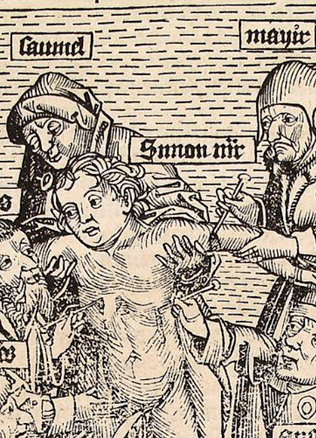Myths About St. Anne’s Church
Vilnius’ St. Anne’s Church is a special monument of ancient Vilnius. This Gothic masterpiece was built at the turn of the 16th century, during the rise of culture in Vilnius. The church, which operated as a chapel for the Bernardine Monastery, was devoted to the brotherhood of St. Anne, and was established by Alexander Jagiellon, however its architect is not known. The complexity of the architecture of this temple of worship shows that it was done by a master mason of high qualification. Perhaps there were more similar structures in Vilnius at the beginning of the 16th century (this premise would be confirmed by what is known as the House of Perkūnas in Kaunas), however no others have survived, thus now St. Anne’s Church seems to be unique and incomparable. It has attracted the glances of people for centuries, and gradually it was shrouded in legends and tales.
The resonant promise of Napoleon
Perhaps the most widespread and most often mentioned myth about St. Anne’s Church in Vilnius is tied to French emperor Napoleon Bonaparte – it is supposedly him who while in Vilnius was so amazed at this monument of Gothic architecture that he cried “I will take this church to Paris in the palm of my hand!” (these words were quoted by Adam Honory Kirkor in his Guide Through Vilnius published in 1859). The basis for this legend comes from the fact that Napoleon was in Vilnius in 1812 during the war against Russia, and would taken valuable artworks from the lands he conquered to France.
Most likely the cult of Napoleon, which was alive in 19th century Lithuania, also contributed to this tale.
However Napoleon did not like monasteries (several were closed down in various places during the years of his rule), and the soldiers of his army did not take care of this Gothic monument: coming back from Russia, the soldiers of Napoleon’s army turned it into a warehouse, and burned its pews, confessionals and other woodworks, and damaged the stone altars.
A story set a century earlier
Another myth tied with the beginning of the church’s history is with the name of Vytautas the Great. Perhaps the one that had the most to do with contributing to this myth was 19th century Lithuanian historian Teodoras Narbutas (Teodor Narbutt), who thought that St. Anne’s Church was built by Jan Puhrbach, a brick mason for the Malbork convent, who was invited by Vytautas’ wife, the grand duchess Ona. He, thought to be helped by a German by the name of Retke, began construction in 1392 and finished four years later. Teodor Narbutt supposedly saw the name of an architect named Retke copied from an inscription on one of the church’s bricks.
Narbutt thought that Vytautas’ third wife, Princess Juliana of Alšėnai, who died in 1448, was buried in the church.
Later these supposed facts were disseminated by A. H. Kirkor and other 19th century writers. The belief that the church was founded by grand duchess Ona contributed to the preservation of the church – it was an influential factor in its restauration at the turn of the 20th century. However, the historical research carried out concerning the church refuted this hypothesis and showed that it arose by accident. Evidence (or at least some of it), which Narbutt and other authors based their work on could in fact be attributed to a second church of St. Anne, which stood within the territory of Vilnius’ castles until the middle of the 16th century and was known with the dual title of the Church of St. Anne and St. Barbara.
Legend of the master and the apprentice
Do You Know?
Though most of the legends surrounding St. Anne’s Church in Vilnius are romantic fiction, this Gothic masterpiece does have its secrets: in one place on the wall of St. Anne’s Church, one can see two bricks in the wall with the signs of the master craftsmen (there are those that believe that these signs were those of the master and his apprentice). Even today no one has been able to decipher and identify these signs.
The third and most poetical legend of these concerning this church is linked with the special aspects of its architectural composition. There are some elements of a myth about the founding of it by Vytautas’ wife that are integrated into the story. The legend was recorded for the first time by Vilnius Jesuit historian Adam Ignacy Naramowski in his book Facies Rerum Sarmaticarum, in Facie Regni Poloniae Magnique Ducatus Litvaniae gestarum (1724-1726) at the beginning of the 18th century. The legend says that the church was built by two master craftsmen, who were invited by duchess Ona from Minsk – the older Vaitiekus, an experienced mason, and his young helper Jonas, Vaitiekus’ son-in-law. Vaitiekus began to build the holy shrine, while his young apprentice was improving his skills abroad. When the old master craftsman put down the foundation and began to build the brick walls, Jonas returned.
After looking over the church that had been started, which Vaitiekus showed him with pride, Jonas noticed that it was not elegant, with heavy shapes and no decorations or ornaments, and he shared these observations with his teacher.
Resentful due to the criticism of his young apprentice, Vaitiekus left the half-built construction and the city. Jonas continued construction: on the flat church roof, he built a graceful upper section with open latticework, figurative columns and three elegant towers on the façade. After many years had passed, Vaitiekus returned home old and weary. Impatiently wanting to see his work, he invited his son-in-law to take a look at the structure that same evening in the moonlight. Upon seeing a wonderful temple of prayer, Vaitiekus was overcome with jealousy and anger. Going up on the scaffolding to the highest point in the church, the old master pushed his young apprentice off it. The young man crashed at the feet of his love Marija and died.
This legend was retold by writer Antanas Ramonas in his book Legends of Vilnius. Fairy Tales (2001). It’s hard to say if there’s a kernel of truth within this legend, or if it’s just a work of an imagination that spurs us to take a closer look at the architecture. In one place on the wall of St. Anne’s Church, one can see two bricks in the wall with the signs of the master craftsmen (there are those that believe that these signs were those of the master and his apprentice). Even today no one has been able to decipher and identify these signs.
Rūta Janonienė




